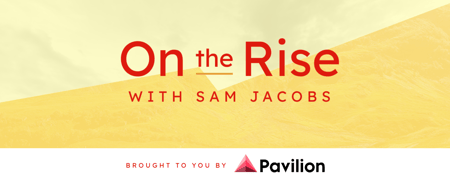
Even before the pandemic, executives across industries debated the future of work—from the growth of digitization and teleworking to the impact of AI technologies in and on the workforce. But the pandemic escalated those conversations, forcing many employers to adopt future practices in the present.
Now that the dust is settling, it’s clear that work will never go back to the way it was— millions of people working strict schedules in offices tied to specific geographies and governed by top-down hierarchies and rigid expectations. A recent report from Pavilion and Operatix found that nearly 95% of SDR teams can work remotely, and 87% of companies are either fully remote or hybrid—a good thing, seeing how 40% of workers say they’d leave their jobs if forced to work full-time in an office. The new workforce is dispersed, diverse, remote, and flexible.
But the future of work is not just about flexibility. It’s also about finding purpose. In Oracle’s AI @ Work study, a staggering 88% of respondents said the meaning of success has changed for them since the pandemic, with nearly a third valuing a meaningful job more than the size of their paycheck. These workers overwhelmingly cited work-life balance, mental health, and flexibility as their top priorities when looking for a job—and if they don’t find what they’re looking for, they’ll walk. That’s one of the driving forces behind what many are calling The Great Resignation—a mass shakeup in the workforce that saw 4.3 million workers quit their jobs in January 2022 alone. In sales alone, there are 137,000 jobs available in North America and only 91,000 candidates to fill those roles, leaving employers desperate to fill posts as they head into periods of turbo-charged growth but lacking candidates willing to fill them.
Executives everywhere have a choice: they can swim with the current or swim against it and sink. Our founder Sam Jacobs also believes in the power of stillness and being aware of where you most often think of new ideas — and aligning your decisions and actions with those driving forces to tap into inner creativity, find inspiration, and make smart decisions for the business.
But there’s a third option here, too. Employers can use the pandemic’s lessons to embrace the future of work, creating a workplace that’s good for their employees and good for their bottom lines—a place that cares for, challenges, and celebrates the whole person as they contribute to the larger vision of the company.
Here are three ways executives can ride the wave and get ahead of the future of work, keeping the strengths of the past while incorporating what the present demands.
Harness tech to inspire teams and individuals
It might sound counterintuitive, but in a time of remote work—where face-to-face check-ins, in-person morale-boosting events, and water-cooler chat is a thing of the past—tech can be a powerful tool for bringing people together. And in a workforce where employees are hungry to grow their careers and make meaningful contributions, tech can help executives and managers develop their teams and take their business to the next level.
Many employees appreciate the perks of working from home—but they miss the camaraderie of the office. Especially in sales—a space that thrives on in-person learning, competition, and high-energy culture—it can be lonely and demoralizing to work alone all day. Executives can overcome some of these challenges by adopting tech platforms that help gamify the workplace experience, creating interactive spaces where people can engage in friendly competition, track individual and team progress, and win prizes, badges, or accolades to move the needle on team projects. A big push day at the office can be replaced by Zoom- or Slack-based power hours, where everyone works towards a common goal and reports their progress to cheers and positive feedback, with regular digital huddles where people can report back on their success and ask questions to the group.
Similarly, companies can use tech to help employees develop and grow their careers. According to the AI@Work study, 73% of workers feel stuck. But many think that technology could help them onto a path of growth and development, with 64% of respondents saying that using AI technology would help them identify the skills they need to succeed, 58% reporting that tech would make them feel more empowered in their career, and 55% saying they’d be more likely to stay with or work for a company that uses AI technology to support employees’ career growth.
Organizations can use digital assistants to check in on employees, identify and track their career goals and serve as a supplement to mentors alongside the team leader. They can also explore AI-based technologies that match people with projects to find the best employees for the job—all internally.
In this way, technology can boost employers’ attempts to understand, engage, mentor, and challenge their workforce, filling critical motivation and mentorship gaps and offering executives key data points to help them provide better training, feedback, and support going forward.
Invest in the whole employee
The pandemic rocked the workplace and the economy and took an enormous toll on employees’ mental, physical, and emotional health. Workers have emerged from the last two years exhausted and vulnerable, whether reeling from the stress of managing at-home childcare, dealing with illness, or putting in long, lonely hours in a deeply uncertain world. According to Forbes, 52% of workers said they experienced burnout in 2021, and 85% said their well-being had declined during the previous year. As employers think about the future of work, they must prioritize the whole employee, creating a workplace that recognizes the pressures they are under inside and outside of work and supports them mentally, physically, emotionally, and financially.
Most major employers have already gotten on board, investing an average of $6 million in corporate well-being programs in 2021—up from $4.9 million in 2020. Over 90% of corporate respondents in a recent survey reported expanding programs targeting stress and sleep management and mental health programs for employees and their young children. Others have responded to a demand for more work-life balance, with 69% expanding leave options or adding new ones, including adopting a child. More than two-thirds have improved their child care support offerings, with 55% expanding paid time off so that their employees could care for children or other family members. Others focused on the financial fallout of the pandemic, rolling out programs to help employees learn about and create savings accounts, manage debts, and budget for the future.
AI can also be an ally in the effort to provide full-spectrum employee health support. Robots can remind frazzled employees (and executives) to take physical breaks, stretch, breathe, meditate and exercise. These wellness breaks can be done alone or even in groups, creating a sense of camaraderie while also lowering collective blood pressure. Companies can also use the data from these efforts to connect healthcare initiatives and employee happiness and productivity, helping make a case for more programs that benefit employee health.
Engage employees wherever they are
There are many benefits to remote and hybrid work, from scheduling flexibility to more time at home with family. But it also has its costs. The shift to remote and hybrid work has also created some level of chaos and isolation, where new and old employees alike feel that they are working in silos without appreciation or a sense of how their contributions are adding up to something bigger. And this can lead to disengagement.
According to a recent Gallup poll, just 36% of US employees feel engaged in their work—not a pretty picture. This is complicated by efforts to onboard new employees across geographies while maintaining a sense of cohesion and company culture. The problems can be logistical, like how to conduct a successful meeting when some people are in person, some are zooming in, and everyone is in different time zones. Problems can also be social, from how to replace the organic, water cooler conversations and observational learning of in-person work with digital substitutes. Left unaddressed, these problems can lead to a crisis of morale.
Disengagement can be a particularly tough problem in sales—a culture that has traditionally thrived in a face-to-face environment with ample opportunity for competition and camaraderie. But as employers shift toward a remote or hybrid model for even the most person-centric jobs, they’ll need to find ways to engage employees digitally in meaningful ways. Some companies are doing this by bringing the water cooler online, creating morning coffee mixers where people can get to know each other, ask advice on some burning work questions, or set up some extracurriculars in person. Other companies are exploring regional hubs where employees who want to work in person can get together with other employees in the same city. Others are experimenting with hosting surprise group competitions and power hours; extracurricular classes taught by different members of the office on everything from sales-based skills to hobbies; and small-group mentoring sessions that allow people to form peer groups and develop in the company in a supported environment.
No matter how work changes, a few things always remain the same: Employees want respect; they want to feel safe; they want to feel challenged, and they want mentorship to reach their goals and dreams. Designing the office for the future of work is about remembering the values of the past and using new technologies, lessons, and findings to apply them to a new, fast-changing world.
For more tips on how to adapt to the future of work and prevent burnout, tune into our upcoming session on Why Investing In Employees’ Mental Health Is The Best Investment.


